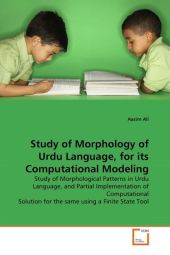 Neuerscheinungen 2010Stand: 2020-01-07 |
Schnellsuche
ISBN/Stichwort/Autor
|
Herderstraße 10
10625 Berlin
Tel.: 030 315 714 16
Fax 030 315 714 14
info@buchspektrum.de |

Aasim Ali
Study of Morphology of Urdu Language, for its Computational Modeling
Study of Morphological Patterns in Urdu Language, and Partial Implementation of Computational Solution for the same using a Finite State Tool
2010. 76 S.
Verlag/Jahr: VDM VERLAG DR. MÜLLER 2010
ISBN: 3-639-28944-7 (3639289447)
Neue ISBN: 978-3-639-28944-2 (9783639289442)
Preis und Lieferzeit: Bitte klicken
Urdu is a morphologically rich language. It has a variety of morphological phenomena in various grammatical categories, e.g. nouns, verbs, adjectives. Urdu has a lot of Noun Morphology, both Derivational and Inflectional. Urdu is rich in generating nouns from existing noun and non-noun words, and using inflections even for gender of un- animated items, which is not possible in English. Honor is also an interesting phenomenon in Urdu Morphology. There are more than 50 Morphological forms (and around 20 Surface forms) associated with a Verb. Like Nouns, Adjectives are divided into two groups: those which have suffixes that change to show gender and number (marked adjectives), and those which do not (unmarked adjectives). There are other grammatical categories in Urdu that have regular Morphological patterns, e.g. Numbers, Particles, and Clitics.
It was very interesting to study the linguistics about my national language, Urdu. The computational viewpoint makes this study challenging, because converting a natural phenomenon into formal procedure is a tricky job. After my MS, I am currently serving as Assistant Professor at Punjab University College of Information Technology, Lahore.


